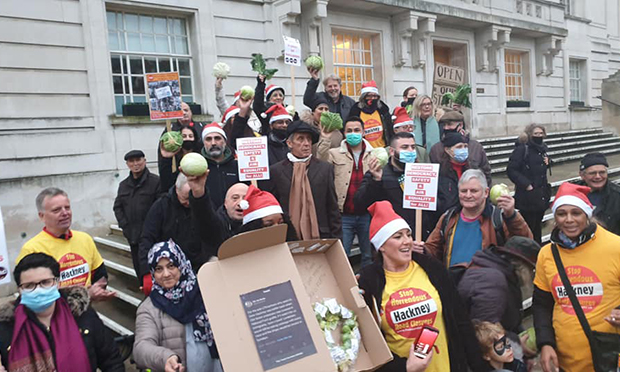Anti-LTN campaign group issues formal legal challenge to Hackney Council

Campaign group Horrendous Hackney Road Closures (HHRC) has issued a High Court legal challenge against the Town Hall’s implementation of Low Traffic Neighbourhoods (LTNs), which they claim have “divided the borough into haves and have-nots”.
The group’s application for a judicial review will be heard on 12 February, alongside similar cases from other boroughs, including Ealing, Hounslow, Lambeth, and Camden, and will claim that the council’s failure to consult the public in advance on the closures was “unlawful”.
The Town Hall’s use of experimental traffic orders (ETOs), which see consultation on schemes undertaken concurrently for up to 18 months rather than beforehand, has long been a focus of ire for those who oppose LTNs.
HHRC will also argue that traffic flow and air pollution impacts were not considered, as well as a disproportionate impact on children, people with disabilities, the elderly, faith groups, and Black, Asian and minority ethnic residents.
Hackney local Ade Alabi said: “Everyone wants cleaner air and safer streets but a policy that disadvantages some residents in favour of others is not the way forward.
“What is needed to tackle traffic hazards is a comprehensive approach, in which all residents are consulted and all roads are considered. Creating higher levels of pollution and congestion on some roads harms cyclists as well. We don’t all just cycle around London Fields on a Sunday afternoon.”
Another resident, Shiva Kashizadeh-Scott, added: “The council doesn’t seem to have considered the pressure and stress on working parents dependent on their car.
“I have to drop my child at nursery at 8am and then be at work by 8.30am. That’s impossible by public transport and its now taking me up to 20 minutes longer just to exit the LTN and then battle through congested roads – I now have to drive further and for longer every day.”
Campaigners are also seeking a court order for Hackney to disclose all information and documents on the planning that went into the implementation of the LTN schemes.
The HHRC group grew out of an active Facebook group, members of which recently formed a not-for-profit company, and has raised £5,240 so far through crowdfunding for its legal campaign.
It is demanding that equality, health, environmental and social impact assessments of the policies are carried out, claiming that there should be “no implementation without consultation”.
The group has levelled criticisms at the council for not giving exemptions to Blue Badge holders, registered carers, Hackney’s NHS Community Childrens Nursing Team or the Orthodox Jewish community’s volunteer medical emergency service Hatzola.
Campaigners are united by a belief that LTNs cause higher levels of congestion and pollution on other roads that have high concentrations of social housing and are used by residents walking to school, work, shops, bus and rail connections and Hackney’s town centres.
The Town Hall announced in November that the introduction of the borough’s three LTNs in Hoxton West, London Fields and Hackney Downs have not caused a rise in traffic levels at its monitoring sites on five A and B roads, according to Transport for London (TfL) data.
Former transport chief Cllr Jon Burke, who resigned at the end of last year, argued at the time that in discouraging motor vehicles from travelling through residential neighbourhoods, the council is sending a message to London Mayor Sadiq Khan about the need to tackle congestion on main roads.
It is understood that HHRC members will use hours of video footage of congestion and traffic on the Together-Legal platform in order to rebut Hackney’s claims that its road closure schemes are working well, with campaigners arguing that overall traffic has not decreased as a result of LTNs but has simply been displaced.
HHRC’s solicitor, Bill Parry-Davies of Dowse & Co., said: “Hackney implemented its LTNs without any prior public consultation, without any current Air Quality Action Plan, without any up-to-date Air Quality Review data or assessment of it, without any clear policy basis for the schemes and, so far as there was any prior assessment or modelling of potential traffic and air pollution impacts, it has refused to disclose it.”
Responding to the points raised in HHRC’s statements, Hackney Mayor Philip Glanville said: “Residents and businesses can have their say online and in writing on the work we’re doing to rebuild a greener Hackney in the wake of the pandemic.
“This is in line with direct guidance from the Department for Transport and Transport for London on supporting people to walk, shop and cycle locally at this time.
“Residents’ views – including those of our diverse communities, older and disabled people – are, and will continue to be, considered alongside traffic monitoring before a decision is made on whether or not to make these measures permanent.
“We are monitoring traffic levels following the introduction of School Streets and Low Traffic Neighbourhoods, and will make adjustments to schemes if necessary.
“I am not anti-car, and I recognise that there are essential journeys that do need to take place by car. Our ambitions and policies are aimed simply at reclaiming Hackney’s roads from unnecessary and short journeys, and supporting people to safely walk, cycle and use public transport.
“This is underpinned by our Transport Strategy and Local Implementation Plan, which were consulted on in 2014 and 2018/19 respectively.”
